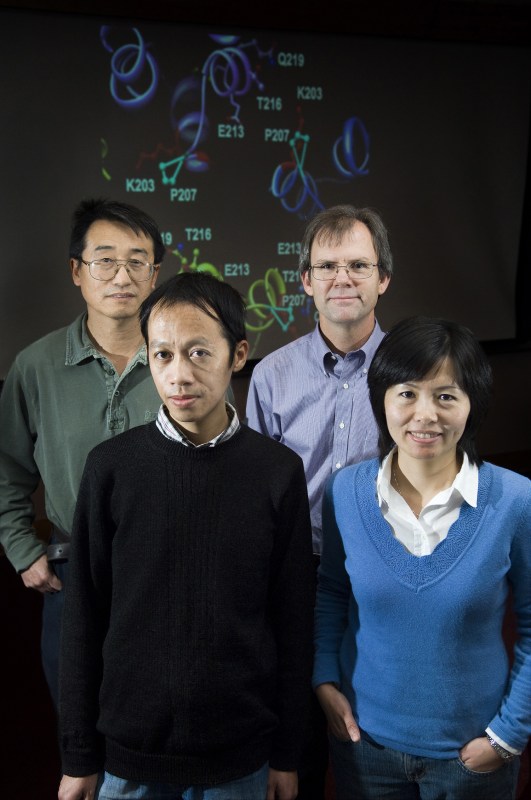
Study team members include, from left, Jing Zhou, Ph.D., Ruifeng Yang, Ph.D., Christopher Aiken, Ph.D., and Jiong Shi. (Photo by Susan Urmy)
Study helps size up HIV’s protective shell
A team of structural biologists and molecular virologists has discovered new structural features of the HIV-1 capsid — the cone-shaped shell that encloses the genetic material of the virus that causes AIDS.
The studies, reported recently in the journal Cell, revealed a novel interface between the capsid's protein subunits that could potentially be targeted for therapy, said Christopher Aiken, Ph.D., professor of Microbiology & Immunology at Vanderbilt University Medical Center.
“Our efforts to understand capsid structure and assembly are with a view towards disrupting that assembly,” Aiken said. “Any perturbation is likely to have an inhibitory effect on virus replication.”
Aiken and his colleagues have had a long-standing interest in the HIV-1 capsid — both its assembly, which must happen to make new viral particles, and its disassembly, which is required to release the genetic material inside an infected cell.
The capsid is composed of about 1,500 copies of a protein called CA. Six individual CA proteins join together in an asterisk-shaped hexamer, and a lattice of these hexamers forms the capsid shell.
In previous research, Aiken and his colleagues had identified certain parts of the CA protein that were critical to capsid stability — when the investigators changed (mutated) these sites, the capsid was unstable. They had also demonstrated that any change in capsid stability — an increase or a decrease — made HIV-1 less infectious.
“It's like Goldilocks and the three bears,” Aiken said. “The capsid stability needs to be 'just right' for optimal infection.”
In the new research, the Vanderbilt investigators collaborated with a group of structural biologists at the University of Pittsburgh. The Pittsburgh researchers used cryo-electron microscopy and nuclear magnetic resonance to take molecular “pictures” of the HIV-1 capsid. Based on the findings, they developed a structural model for the fully assembled viral capsid that showed new contacts between the hexamers.
The new contacts included some of the same sites Aiken's team had already demonstrated were important for capsid stability.
“None of the previous structural data had been able to explain our findings, but these new structural models possibly can,” Aiken said.
Ruifeng Yang, Ph.D., a postdoctoral fellow in Aiken's group, made additional mutations within the newly identified region, which resulted in HIV-1 with marked reductions in infectivity. Jiong Shi, a senior research specialist, showed that the mutations stabilize the viral capsid.
The team also sought to provide experimental evidence for the hexamer contacts predicted by the model. By making directed mutations and then binding the separate proteins together, they were able to demonstrate links between three different hexamers.
Aiken's group will continue to explore the role of this newly identified interface in HIV infection. The researchers also are searching for and identifying biologically relevant interactions of HIV with host proteins.
Peijun Zhang, Ph.D., and Angela Gronenborn, Ph.D., led the structural biology work at the University of Pittsburgh. The National Institutes of Health supported the research.













